5JSC/RDA/Part I/CCC response March 17, 2006 p. 1 - Joint Steering ...
5JSC/RDA/Part I/CCC response March 17, 2006 p. 1 - Joint Steering ...
5JSC/RDA/Part I/CCC response March 17, 2006 p. 1 - Joint Steering ...
You also want an ePaper? Increase the reach of your titles
YUMPU automatically turns print PDFs into web optimized ePapers that Google loves.
<strong>5JSC</strong>/<strong>RDA</strong>/<strong>Part</strong> I/<strong>CCC</strong> <strong>response</strong><strong>March</strong> <strong>17</strong>, <strong>2006</strong>p. 1To:From:Subject:<strong>Joint</strong> <strong>Steering</strong> Committee for Revision of AACRCanadian Committee on Cataloguing<strong>RDA</strong> – Draft for constituency review (December 2005) part I<strong>CCC</strong> has reviewed the <strong>RDA</strong> – Draft for constituency review (December 2005) part I and offersthe following comments.References have been made to some examples if they relate to clarification of the rulesthemselves. In those instances when examples are also affected, the comment is followed byAlso Examples Group.General commentsWhen optional guidelines provide an alternative to an instruction, <strong>CCC</strong> suggests usingalternatively instead of optionally.The Definitions were found to be very helpful, especially placed where they are most relevant.We note, however, some inconsistencies in the definitions. Some seem to indicate simply howthe word or phrase is used in <strong>RDA</strong> (e.g. 4.3.0.1 scope of content, 4.10.0.1 related content); othersprovide a full definition of the word itself (e.g., 4.13.0.1 scale, 4.9.0.1 index, finding aid). Theinconsistency proved distracting.The distinction between transcribe and record was not always clear although this may be becauseof the former understanding of “transcribe” (e.g., 2.4.0.4 vs. 2.4.0.5, 2.4.0.6, 2.4.0.11).Giving notes is identified by “make”, whereas giving an access point is generally associated with“record”. However, in some cases, an access point can be in the form of a note or vice versa(e.g., 2.3.4.3 and 2.3.8.3). As it appears to have some bearing on the use of terminal punctuationin the examples, is this distinction necessary when descriptive elements are used as access points?Also Examples GroupWithout the appendix for abbreviations, it was sometimes difficult to identify whereabbreviations would be or could be used. Also Examples GroupChapter 1 General guidelines on resource description1.0: This chapter states that it “provides general guidelines on determining the appropriate typeof description to use [i.e., comprehensive, analytical or multilevel]”. Since there are noguidelines for cataloguers to help them to determine which type of description is appropriate, wesuggest rewording as follows:This chapter provides general guidelines regarding the appropriate type of description touse….1.1.1: The term archival resource is used throughout the rules (e.g., 2.3.7.3, 2.9.5.3, 5.3.0.4,6.3.1) and should be defined in a subsection of 1.1 as well as in the Glossary. The definition ofarchival resource should not leave any ambiguity as to whether a collection of two or more units
<strong>5JSC</strong>/<strong>RDA</strong>/<strong>Part</strong> I/<strong>CCC</strong> <strong>response</strong><strong>March</strong> <strong>17</strong>, <strong>2006</strong>p. 2assembled by a collector, institution, etc., is or is not an archival resource. A definition inclusiveof organic aggregations of records, papers, fonds, etc., and of collections is recommended.1.1.1, bullet 3: Suggest that last example read: (e.g., three maps).1.1.1, bullet 4: “as set” should read: “as a set”.1.1.3, bullet 2: Add as the second sentence the following as an Exception:Consider resources that exhibit characteristics of serials but whose duration is limited(e.g., newsletters of events) as serials.1.2.1, bullet 1, i): a “personal web page” is not a good example of a single part resource as itcould be an integrating resource. Suggest that a single PDF document is a much clearerelectronic example. If retained, note that “Web” site at both i and iii should be capitalized. Cf.1.1.2, 2 nd and 4 th bullets.1.2.1, bullet 1: Add: vi) an archival resource, or, alternatively, if archival resource is defined asrecommended above, revise v) in terms of archival resource.1.2.3, bullet 2, a): There are two ways of displaying multilevel descriptions, i.e., as separatedescriptions or as hierarchical multilevel descriptions. D.1.4 addresses a hierarchical display butthere is no display guidance for separate linked descriptions. <strong>CCC</strong> therefore suggests adding“linked” and a footnote as follows:either a) as separate linked descriptions 22For additional guidance, see Describing Archives: a Content Standard (DACS) and Rules forArchival Description (RAD).1.3, heading: Since 1.3 is applicable to serials only, the heading should reflect this.1.4, para 1: As there can be more than one person, etc., with principal responsibility in a singlestatement of responsibility, suggest the following (cf. 2.4.0.3):Statement of responsibility (persons, families, or corporate bodies with principalresponsibility) 2Also suggest the addition of a see reference in the footnote:2 If there is more than one statement of responsibility, include as a minimum a statementidentifying the persons, families, or corporate bodies with principal responsibility for theintellectual or artistic content of the resource (see 2.4.0.6).Suggest that only footnote 3 be given, i.e., the parenthetical statement at Publisher, distributor,etc., is unnecessary.<strong>CCC</strong> notes that information on coordinates of cartographic content is an optional addition inAACR2. Should coordinates of cartographic content be considered mandatory now?1.4, para 2, option: <strong>CCC</strong> does not support the option to provide a controlled access point in lieuof the mandatory statement of responsibility and suggests its removal. Although it may save key
<strong>5JSC</strong>/<strong>RDA</strong>/<strong>Part</strong> I/<strong>CCC</strong> <strong>response</strong><strong>March</strong> <strong>17</strong>, <strong>2006</strong>p. 3strokes, it could have negative implications for the identification of the resource and authoritycontrol.1.5, bullet 4, Exception: Suggest deleting “title or”; instruction to read:Record a quotation incorporated into notes in the language and script in which it appearson the source from which it is taken.1.6: Suggest that more specific instruction be given to indicate that transcription coverspunctuation as it appears. There should also be a reference to appendix D on giving additionalpunctuation not present on the source for greater clarity in presentation, or, substitutingpunctuation present on the source if there is conflict with prescribed punctuation for display (e.g.,ISBD punctuation). See also comment at Appendix D.1.6.2.1, bullet 2: The option at 1.6.2 for early printed resources applies only to the editionstatement, a statement relating to a named revision of an edition, or date of publication,distribution, etc. There should also be an option for early printed books not to follow theinstruction to change Roman numerals to lower case for paging and page references. Cf. AACR2C.1A1.6.2.5, bullet 1: Using both “transcribing” and “record” in the instructions might be an issue incases such as, 2d versus 2nd. Suggest following AACR2 (C.8A):In the case of English-language sources, record ordinal numerals in the form 1st, 2nd,3rd, 4th, etc.1.6.2.5, bullet 2: same comment as at 1.6.2.5, bullet 1; additionally, add to the French example:2 d (for second) and 2 de (for seconde).1.6.2.5, bullet 3: same comment as at 1.6.2.5, bullet 1.1.6.3: <strong>CCC</strong> would like accents and other diacritical marks to be added in all cases, with theexception of early printed resources . Suggest that the wording of AACR2 1.0G1 (with the minorchange) be followed with the exception noted:Add accents and other diacritical marks that are not present in the data found on thesource of information in accordance with the usage of the language used in the context.Exception:For early printed resources, do not add accents and other diacritical marks not present onthe source.1.6.6: <strong>CCC</strong> notes that there are examples where it would be difficult to apply this instruction andsuggests that an option be added to repeat a letter or word:Optionally, if a letter or word appears only once but the design of the source ofinformation makes it clear that it is intended to be read more than once, repeat the letteror word without the use of square brackets.1.6.8: The AACR2 practice of correcting inaccuracies in square brackets is preferred since: a) itconveys more succinctly and more helpfully the desired information; notes are often not includedin brief displays or disregarded by users, and b) cataloguer’s typos are more easily distinguishedfrom dutifully transcribed errors.
<strong>5JSC</strong>/<strong>RDA</strong>/<strong>Part</strong> I/<strong>CCC</strong> <strong>response</strong><strong>March</strong> <strong>17</strong>, <strong>2006</strong>p. 4Chapter 2 Identification of the resource2.1.1, Contents: Add: 2.1.1.1 Resource issued as a single unit; renumber existing 2.1.1.1,2.1.1.2, and 2.1.1.3 to 2.1.1.2, 2.1.1.3, and 2.1.1.4 respectively.2.1.1: Create a new section and reword the first bullet at 2.1.1 as follows:2.1.1.1. Resource issued as a single unit• Choose as the basis for the identification of the resource a source of informationidentifying the resource as a whole.The existing 2.1.1.1, 2.1.1.2, and 2.1.1.3 should be renumbered to 2.1.1.2, 2.1.1.3, and 2.1.1.4respectively.2.1.1, last bullet: Renumber 2.1.1.3 as 2.1.1.4.2.1.1.1, first bullet, ii and iv: Suggest the following rewording:ii) a source of information identifying the earliest issue or part (i.e., the issue or part withthe earliest date of publication, distribution, etc.), if the issues or parts are unnumbered orwere not issued in the order of their sequential numbersiv) a source of information identifying the earliest issue or part available, if the issues orparts are unnumbered or were not issued in the order of their sequential numbers and theearliest issue or part is not available.2.1.1.1, last bullet: For consistency, suggest that “the basis for the identification of the resource”be used in place of “basis of the description”.2.1.2b, para 2: Renumber 2.1.1.3 to 2.1.1.4.2.2.1, footnote 1: Suggest removing the exclusions noted in the footnote so that they areconsidered part of the resource itself. This would serve to simplify the decision of the cataloguerwith regard to when any housing is an integral part of the resource (i.e., kits) and reduce the needfor square brackets. The footnote can stand with the removal of “but excludes,” or for greaterclarity be reworded as follows:The resource itself includes the storage medium (e.g., paper, tape, or film), any housing(e.g., a cassette or cartridge) that is an integral part of the resource, any accompanyingmaterial and any container that is separable from the storage medium and/or housing(e.g., case or box).This change would also require a revision to 2.2.3, i.e., the removal of a) and b).2.2.1.1, bullet 2: Suggest deleting “or an image…of preference indicated)” and rewording asfollows:a) a cover (or cover image)b) a caption (or caption image)c) a masthead (or masthead image)d) a colophon (or colophon image).2.2.1.1, bullet 3: The meaning of “formally presented sources” is ambiguous. A source cannot beformally presented; only the information can be formally presented. Suggest rewording as:
<strong>5JSC</strong>/<strong>RDA</strong>/<strong>Part</strong> I/<strong>CCC</strong> <strong>response</strong><strong>March</strong> <strong>17</strong>, <strong>2006</strong>p. 5“giving preference to a source where the information is formally presented”. Additionally, <strong>CCC</strong>suggests that a definition be given for “formally presented”. The following is based on thedefinition found in the CONSER manual:Formally presented —i.e., appearing in isolation, as opposed to appearing embedded intext, and in a prominent location.2.2.1.2: <strong>CCC</strong> feels that provisions for “Resources comprising a set of graphic images” areunnecessary and should be removed.<strong>CCC</strong> suggests that “Resources comprising sound” would be useful with provisions for using a)information permanently printed on or a label affixed to the resource or, b) an electronic “label”in textual form or, c) accompanying material or container if it furnishes a collective title and othersources do not.2.2.1.2, bullet 1: If retained as is, add a comma after the first occurrence of “etc.”2.2.1.2, bullet 2: If retained, add a comma after the closing parenthesis.2.1.1.3, option: Suggest the following rewording:Optionally, use eye-readable information permanently printed on or a label affixed to theresource in preference to the title frame(s) or title screen(s).2.2.1.4: With the addition of Resources comprising sound, suggest the following:2.2.1.4. Other resources• For a resource other than one covered under 2.2.1.1—2.2.1.3, use as the preferredsource of information, the resource itself, giving preference to a source where theinformation is formally presented.2.2.1.4, last bullet: Suggest that the first example read: (e.g., a title panel on a folded map…)2.2.4, exception: In the parenthetical statement, suggest giving “assembled collection” or“archival resource” as an example rather than “collection”.2.3: There is no definition for an alternative title. Additionally, there are no instructionsregarding the use of “or” (or its equivalent) (cf. AACR2, 1.1B1, para 3) although there areexamples at 2.3.0.3 (Under the hill, or, The story of Venus and Tannhäuser) and 2.3.1.7 (MarcelMarceau, ou, L’art du mime) illustrating this.2.3.0.1: Suggest that the section regarding devised title immediately follow 2.3.1 instead of beingaddressed at 2.3.7.2.3.0.3: See comments at 2.3.2.3.0.5: This instruction is an exception to the general transcription instruction. Suggest that it bereflected as such at 2.3.0.3.2.3.0.7, bullet 2: Use of the terms “enumeration or designation” when referring to title of thepart, section, or supplement may cause some confusion in transcription. It should be made clearthat in such instances the title proper includes these “designations” and should, therefore, be
<strong>5JSC</strong>/<strong>RDA</strong>/<strong>Part</strong> I/<strong>CCC</strong> <strong>response</strong><strong>March</strong> <strong>17</strong>, <strong>2006</strong>p. 6transcribed as per 1.6.2, bullet 1 and not the guidelines in 1.6.2.1-1.6.2.5 for “numeric and/oralphabetic designation, etc.”, i.e., Series II, Reactors vs. Series 2, Reactors.2.3.0.7, bullet 3: The term “monographic series” is being introduced here; could this term begiven at 1.1.3 as part of the “e.g.”?2.3.1.7a, para 2: Add a comma after the second occurrence of “etc.”2.3.1.12: Given that this rule applies only to serials, suggest that “serials” appear in the headingas follows: Major and minor changes in the title proper of serials.2.3.1.12 b) minor changes, v: Is this condition at “v” only applicable in the context of an ISBDpresentation? See comments at 2.3.2.2.2.3.2.2: In Canada, publications are often issued in the two official languages either as separateEnglish and French publications or as bilingual publications. When issued bilingually,publications are either issued with a bilingual title page and with English and French in parallelcolumns or they are issued with separate title pages and with the languages inverted (tête-bêche).Following AACR2, the other language title is not considered a parallel title since it does notoccur on the same source as the title proper. This is no longer the case with <strong>RDA</strong> - a parallel titlecan be taken from any source. For a labeled display, there is no problem; however, for an ISBDpresentation, it would be misleading to display (and could cause difficulty in identification) totreat a title appearing on an added title page (or cover, etc.) as a parallel title. For this reason,<strong>CCC</strong> recommends that the source of information for a parallel title be the same source as the titleproper.2.3.3.2: Given that other title information may appear in conjunction with titles other than a titleproper (e.g., parallel title, series title), suggest that this be reflected in the instruction.2.3.3.3, first bullet: <strong>CCC</strong> suggests that cataloguers should not have to make judgements inconsidering what is important in all cases. This should only be limited to serials and integratingresources. The following rewording (cf. format at 2.3.1.4) is suggested:Record other title information appearing on the same source of information as the titleproper following the basic instructions on recording titles (see 2.3.0).Exceptions:a) SerialsRecord other title information appearing on the same source of information as the titleproper only if considered to be important (either for identification or for access).b) Integrating resourcesRecord other title information appearing on the same source of information as the titleproper only if considered to be important (either for identification or for access).2.3.3.3, final bullet: These instructions should not apply to monographs. Suggest that theseinstructions be treated as Exceptions for Serials and Integrating resources.2.3.3.4, first bullet: Suggest adding the following as in AACR2 1.1E6 (the wording is similar to<strong>RDA</strong>, 1.5, bullet 2):
<strong>5JSC</strong>/<strong>RDA</strong>/<strong>Part</strong> I/<strong>CCC</strong> <strong>response</strong><strong>March</strong> <strong>17</strong>, <strong>2006</strong>p. 7…supply a brief addition as other title information, in the same language and script as thetitle proper.2.3.3.4, bullet 2, a): Suggest rewording as follows:If the title proper of the resource does not include an indication of the geographic areacovered and/or subject portrayed, and,a) the other title information does not include such an indicationor b) there is no other title informationadd a word or brief phrase indicating the area covered, and, if applicable, the subjectportrayed, as other title information.2.3.3.6c: The see references to 2.3.5.6c in the second and third paragraphs should all be correctedto 2.3.5.6b.2.3.7.3, first bullet: Suggest adding a see reference to 2.3.1.10 to relate recording a devised titleas the title proper which also justifies the see reference to 2.2.4 at 2.3.7.3, bullet 3:If the resource itself bears no title (see 2.3.1.10), and a title cannot be found in any of theother sources of information specified in 2.2.3, devise….2.3.7.3, bullet 2: Suggest moving these instructions to be a subsection of 2.3.7.4. This wouldclarify that these instructions are additional to the specifications given in bullet 1 of 2.3.7.3.2.3.7.3, penultimate bullet: Delete the see reference to 2.2.4 at the end of the sentence as itprovides no additional guidance.2.3.7.4b: Suggest rewording as follows:Always include in the devised title the name of the area covered, and, if applicable, thesubject portrayed.2.3.8.3: An exception should be provided for recording the source of a devised title of an archivalresource, particularly if that resource is described comprehensively, e.g., a fonds or collection.The 5 th example, Title devised by cataloguer [archivist, etc.], will be repeated for the vastmajority of archival resources described comprehensively.Note that to be consistent with the change proposed at 2.2.1.2, the following rewording of b) issuggested:b) information permanently printed on or a label affixed to a resource comprising sound(see 2.2.1.2)2.3.8.4, bullet 1: There can be scattered issues and parts but scattered iterations do not seemprobable. Suggest “occasional” iterations.2.3.8.4, bullet 2, option: The instruction “in lieu of making a note” implies that it is not possibleto give both a note and an access point.2.4.0.3, option: <strong>CCC</strong> does not support the option and suggests its removal. Although itsapplication may save key strokes, it could have negative implications for the identification of theresource and authority control.
<strong>5JSC</strong>/<strong>RDA</strong>/<strong>Part</strong> I/<strong>CCC</strong> <strong>response</strong><strong>March</strong> <strong>17</strong>, <strong>2006</strong>p. 82.4.0.5: Reference is made to “mark of omission” (without …) at other instructions, e.g., 2.3.1.7b,2.10.1.3, Exception. Should it be included with the appropriate “…”in chapter 1 as a generalizedinstruction? (Cf. AACR1 1.0C1)2.4.3.1, first bullet: A note on a statement of responsibility should not be restricted to thoseplaying subsidiary roles since it is possible that persons, families, and corporate bodies can play amajor role and not be named in the resource.2.5.1.5, first bullet: The rule reference should be to 2.11 (not 2.5.11).2.5.1.5, bullet 2: The rule reference should be to 2.6 (not 2.5.6).2.6.0, heading: Since Numbering is applicable to serials only, this should be reflected in theheading.2.6.0: It is not clearly stated that numbering is to be given as numbering only “if cataloguing fromthe first and/or last issue or part” (cf. 12.3A1). This reference only appears at 2.6.1.3 and shouldappear at 2.6.0.3.2.6.1: A reiteration of a reference to abbreviation at 1.6.7 is not necessary here?2.7.0.3 and 2.8.0.3: Clarification of name of publisher and place of publication is not consistentwith clarification of dates (e.g., fictitious, misleading dates at 2.9.0.3). Suggest that ability tosupply in square brackets (instead of notes) be consistent for all these elements (i.e., place, nameof publisher, distributor, etc., and dates). The <strong>CCC</strong> preference is not to make notes but to includethis information in square brackets.2.7.1.3 bullet 3: The publisher element is not appropriate for a resource in an unpublished form.The heading “no publisher identified” implies that a publisher must exist but just is not named.Suggest that the heading be changed to:No publisher identified or no publisher2.8.0.4: There is no limit on the number of places of publication to be recorded. There should beprovision not to transcribe all place names if it is not considered to be important to list them all.2.8.0.6b: Add: If the changes have been numerous, a general statement may be made.2.8.0.6c: Add: If the changes have been numerous, a general statement may be made.2.8.1.3, first bullet: For consistency, instead of “identified”, use “named” as at 2.9.0.2.Additionally, to illustrate that local jurisdiction, etc., can be included in the supplied place ofpublication, suggest the following rewording with appropriate examples. Also Examples Group:If the place of publication is not named in the resource, supply in square brackets theplace of publication or probable place of publication, including the larger jurisdiction ifnecessary for identification, as follows (in order of preference):2.8.1.3, bullet 3: The place of publication element is not appropriate for a resource in anunpublished form. The heading “place of publication not identified” implies that the place is justnot named. Suggest that the heading be changed to:
<strong>5JSC</strong>/<strong>RDA</strong>/<strong>Part</strong> I/<strong>CCC</strong> <strong>response</strong><strong>March</strong> <strong>17</strong>, <strong>2006</strong>p. 9Place of publication not identified in the resource or no place of publication2.8.5.4 a), b), c): References should be to 2.8.0.6 a) b), c) instead of to 2.7.0.7 a), b), c)respectively.2.8.5.4 b) & c): For consistency, add a comma after “etc.” as at 2.8.5.4 a).2.8.5.4 c), 1st sentence: “names of publishers, distributors, etc.” should read “places ofpublication, distribution, etc.”.2.9.0.2, bullet 3: There should be consistency in the use of “named” vs. “identified” (cf. 2.9.1.3).2.9.0.3: Rule 1.4F1 in AACR2 is very specific that it is the year that is to be given as the date.This should also be stated in <strong>RDA</strong>.2.9.0.3 opt a: The option in this area differs from all other elements in that an explanation can begiven in square brackets versus only in a note (cf. 2.7.0.3, 2.8.0.3). An actual date should be ableto follow an incorrect date as well as a fictitious date:a) if the date as it appears in the resource is known to be fictitious or incorrect, follow itwith the actual date2.9.0.5, bullet 4: This instruction should be broadened to include all integrating resources and notbe restricted only to “updating loose-leafs”. Add “in square brackets”.2.9.0.5, bullet 6, opt: For consistency (cf. 2.9.0.3), add “in square brackets” as follows:Optionally, supply in square brackets the beginning and/or ending publication date inthe…2.9.1.3, bullet 2: These examples should be part of the text of the instructions and should not beconsidered as examples (cf. format of AACR2 1.4F7). The examples should illustrate the rulesand not have the rules be implicit in the examples. Additionally, the listing should also cover thefollowing situation:[between 1850 and 1900](Span of dates certain)Preference is also given to retaining [197-], etc., instead of [1970s], etc., since the <strong>RDA</strong> forms ofuncertain dates are not language neutral.2.9.1.3, final bullet: This instruction is also a case where the date of publication is not applicable.Suggest that the heading be changed to:Date of publication not identified in the resource or no date of publication2.9.3.2: Add a second bullet:If both a phonogram date and a copyright date appear in the resource, record only thephonogram date.2.9.5.3, final bullet: There is an inconsistent use of terminology between this rule (“undated”)and 2.9.1.3 (“date unknown”) in regard to the absence of date information for the resource.Undated means simply that there is no date on or in the resource. Date unknown means this and
<strong>5JSC</strong>/<strong>RDA</strong>/<strong>Part</strong> I/<strong>CCC</strong> <strong>response</strong><strong>March</strong> <strong>17</strong>, <strong>2006</strong>p. 10that the cataloguer, etc., is unable to find or estimate a probable date or range of dates. For thisreason, date unknown is preferred in both rules.2.10.0.5: Since changes between parts can occur, provision has not been made for a change inseries information for multipart monographs issued simultaneously.2.10.3.3: Reference should be to 2.3.3 since 2.3.3.5 is also applicable.2.10.5.3: Refers to 2.12.1.1 for recording incorrect series ISSNs, but shouldn’t 2.12.1.3 actuallyapply?2.10.6.7a: Retain within the instruction “multipart monograph” as in the rule heading, i.e., not“multipart resource”.2.11.0.3, bullet 2: For consistency, remove “Frequency varies” or “Frequency of updates varies”from the text of the instruction and have them appear only as examples. Also Examples Group2.12.0.1, 1st bullet: Add “a”, i.e., is “a” number or code….2.12.0.4: Should read 2.12.0.3?2.12.2.2, option: <strong>CCC</strong> notes that music numbers often include hyphens and proposes that a dashbe used instead of a hyphen when recording consecutive numbers.2.14.1a) and c): <strong>CCC</strong> notes that combining information in a single note is not done in practice.We are submitting this comment to see if other JSC constituents follow this instruction since ithas been taken from AACR2. If not, we suggest that this provision be removed.2.14.1c: Delete the last sentence since numbering is not applicable to multipart monographs (cf.2.6.0.1 definition).Chapter 4 Content description4.1: Suggest that it be stated explicitly that information used for content description should firstbe taken from the resource itself, and then, if not clear, be taken from sources outside the resource(or any source). A similar provision is given at 3.1.1.4.3 and 4.6: Archival standards do not differentiate between nature and scope of the contentand summarization of the content. ISAD, RAD, and DACS all have in common a contextsettingelement of description called Scope and content. The last two examples under rule4.6.0.3 (Summarizing the content) are good examples of a scope and content for an archivalresource. The terminological differences are bound to be a source of confusion as applied toarchival resources. Is there sufficient distinction to justify two separate elements?4.4.0.3: Is the term “closed captioning” without mention of any specific language an example of alanguage difference? The “Closed-captioning in German” example does not make this obvious.(Cf. AACR2 7.7B2) Also Examples Group4.8: Add a period after “8” in the heading.
<strong>5JSC</strong>/<strong>RDA</strong>/<strong>Part</strong> I/<strong>CCC</strong> <strong>response</strong><strong>March</strong> <strong>17</strong>, <strong>2006</strong>p. 114.9.0.1: The following definition of finding aid is preferred:A finding aid is a descriptive tool providing access to a resource. The finding aid mayhave been received by the repository along with the resource or may have been createdby the repository in the course of establishing administrative or intellectual control overthe resource.4.11: <strong>CCC</strong> does not object to transcribing statements about the musical layout of music, e.g.,“vocal score” or “piano reduction”, as format. However, it is inconsistent to transcribe formatelsewhere when it includes a statement of responsibility. Format should be treated like editioninformation and always be transcribed in the same place. In order to do this, the instructionshould be modified to allow transcribing statements of responsibility related to format and usingabbreviations as for edition information.4.10.1.5: There are two opening parentheses and only one closing one.4.12.0.3, bullet 2: This works only for notated music; order is not specified in sound recordings.4.13.0.2: 4.13.0.3, bullet 3 states that a scale can be found outside the resource, and bullet 4 statesthat a scale can be estimated. For consistency, there should be another bullet at 4.13.0.2 to allowfor this (cf. 2.3.1.2, bullet 2):If there is no scale provided within the resource itself, take the scale of cartographiccontent from outside the resource.4.13.1: Why is punctuation given as part of the instruction here? If here, why not also at 4.7.0.3?Cf. <strong>5JSC</strong>/Sec/4 (Punctuation within elements)4.13.1a: Should the term “cataloguer” be retained?4.13.2: The ACMLA rep feels strongly that the options at 3.3B4 in AACR2 should be included at4.13.2:Optionally:a) If the description is of a cartographic item with two or more scales, and theprojections and/or coordinates are also different for each main item, give eachscale in a separate scale statement. If there is more than one title, give the scalestatements in the same order in which the titles are given. If there is only acollective title, give the largest or larger scale first.[example not transcribed]b) If the description is of a cartographic item with two or more scales, and theprojection and coordinates are the same for each main item, give the scales in onescale statement. If there is more than one title, give the scales in the same orderin which the titles are given. If there is only a collective title, give the largest orlarger scale first.[example not transcribed]4.15.0.2: Add another bullet:If there is no coordinates provided within the resource itself, take the coordinates ofcartographic content from outside the resource.
<strong>5JSC</strong>/<strong>RDA</strong>/<strong>Part</strong> I/<strong>CCC</strong> <strong>response</strong><strong>March</strong> <strong>17</strong>, <strong>2006</strong>p. 124.<strong>17</strong>.0.3, para 3: “record” the scale(s) vs. “make notes” on the scale (4.13.5)—terminalpunctuation? Also Examples Group4.18.0.3: Explicit instructions on using prescribed punctuation seem to be out of sync with therest of the guidelines. Suggest that an option similar to the 2 nd option at 1.6 and 1.7.1 be given:Optionally, if the information used in a note is derived from a digital source using anautomated scanning, copying, or downloading process (e.g., by harvesting embeddedmetadata or automatically generating metadata), record the information as it appears onthe source.4.19.0.1: Add a comma after “etc.”Chapter 5 Information on terms of availability, etc.No comments.Chapter 6 Item-specific informationChapter heading: Not all the instructions in this chapter address “item-specific” information,e.g., 6.4 and 6.5 are more general.6.2.0, heading: Add a period after “0” in the heading.6.3: The definition of provenance is not one which is accepted in archival standards; rather itdefines the concept of “custodial history”. We support renaming this section Custodial historyand immediate source of acquisition.6.3.0, heading: Add a period after “0” in the heading.6.4.0, heading: Add a period after “0” in the heading.6.5.0, heading: Add a period after “0” in the heading.6.6.0, heading: Add a period after “0” in the heading.Appendix DAs part of the instructions on presentation of data, there should be an option to add punctuation ifit clarifies the description of the resource (e.g., the addition of commas to a list of names or titlespresented vertically on the source), or to substitute punctuation present on the source when it is inconflict with prescribed punctuation for data display (e.g., the replacement of a colon with acomma between the name of a person and his or her function).D.1.2.0, first bullet: Suggest adding the following to the end of the sentence (cf. ISBD(G) 0.43):…unless the area begins a new paragraph, in which case the full stop, space, dash, spacemay be omitted or replaced by a full stop given at the end of the preceding area.D.1.2.2: Suggest adding:Precede a subsequent statement relating to an edition by a comma.Instructions on how to transcribe edition statements associated with different works in a resourcelacking a collective title (AACR2 1.2B6) are lacking.
<strong>5JSC</strong>/<strong>RDA</strong>/<strong>Part</strong> I/<strong>CCC</strong> <strong>response</strong><strong>March</strong> <strong>17</strong>, <strong>2006</strong>p. 13D.1.2.7: Add instruction from AACR2 1.7A3 about punctuation used when information in notescorresponds to that of the body of entry.


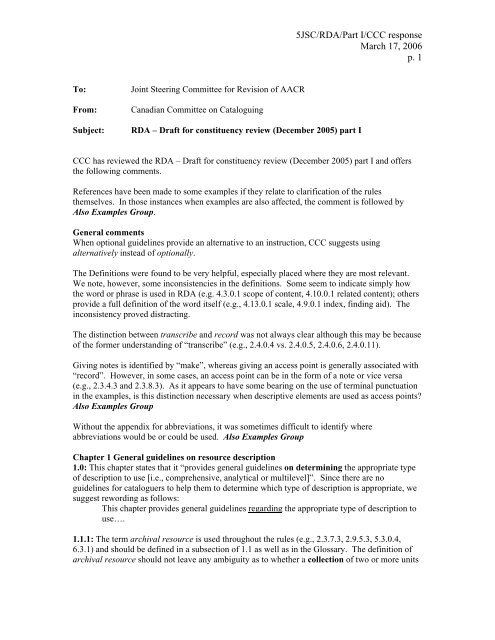

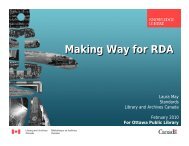
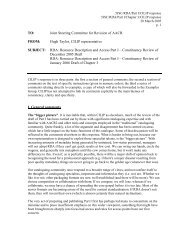
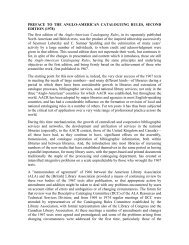
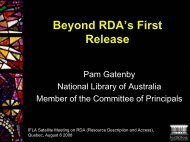



![Presentation slides [PDF] - Joint Steering Committee for ...](https://img.yumpu.com/41621230/1/190x143/presentation-slides-pdf-joint-steering-committee-for-.jpg?quality=85)
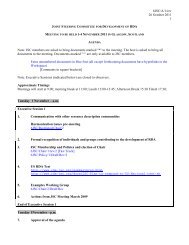
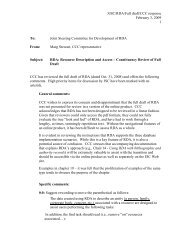
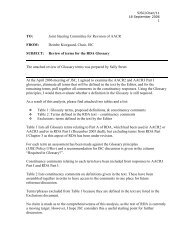
![Presentation slides [PDF] - Joint Steering Committee for ...](https://img.yumpu.com/35256207/1/190x143/presentation-slides-pdf-joint-steering-committee-for-.jpg?quality=85)
